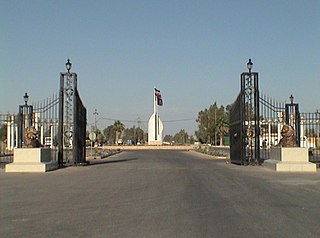 W
WThe Battle of Tuz Khormato refers to the a battle fought during the 1991 uprisings in Iraq between the Peshmerga and Iraqi forces. Tuz Khormatu, a predominantly Turkmen town, was one of the most southernly towns to fall under the control of the Peshmerga.
 W
WThe Battle of Sulaymaniyah was one of the biggest battles fought during the 1991 uprisings in Iraq. Sulaymaniyah, a Kurdish city with a population of over 100,000, was the first Iraqi city to be captured by rebels and the last one to fall. The city was recaptured by Kurdish rebels, after the Peshmerga launched a new offensive on 20 July.
 W
WBlack September, also known as the Jordanian Civil War was a conflict fought in the Hashemite Kingdom of Jordan between the Jordanian Armed Forces (JAF), under the leadership of King Hussein, and the Palestine Liberation Organisation (PLO), under the leadership of Yasser Arafat, primarily between 16 and 27 September 1970, with certain aspects of the conflict continuing until 17 July 1971.
 W
WOn April 8, 2011, the Iraqi Army launched a raid against the People's Mujahedin of Iran, an Iranian opposition group based at Camp Ashraf. 34 people were killed and 318 injured in the raid. The attack was denounced as a "massacre" by PMOI leader Maryam Rajavi and U.S. Senator John Kerry.
On 28 June 1981, a powerful bomb went off at the headquarters of Islamic Republic Party (IRP) in Tehran, while a meeting of party leaders was in progress. Seventy-three leading officials of the Islamic Republic of Iran were killed, including Chief Justice Ayatollah Mohammad Beheshti the second-most powerful figure in the Iranian Revolution. The Iranian government first blamed SAVAK and the Iraqi regime. Two days later, the People's Mujahedin of Iran was accused by Khomeini.
 W
WThe Iran hostage crisis was a diplomatic standoff between the United States and Iran. Fifty-two American diplomats and citizens were held hostage after a group of militarized Iranian college students belonging to the Muslim Student Followers of the Imam's Line, who supported the Iranian Revolution, took over the U.S. Embassy in Tehran. and seized hostages. The hostages were held for 444 days from November 4, 1979, to January 20, 1981.
 W
WThe Iran–Iraq War was a protracted armed conflict that began on 22 September 1980 when Iraq invaded neighbouring Iran. The war lasted almost eight years, ending in a stalemate on 20 August 1988 when Iran accepted a UN-brokered ceasefire. Iraq's rationale for the invasion was primarily to cripple Iran and prevent Ayatollah Ruhollah Khomeini from exporting the 1979 Iranian Revolution movement to Shia-majority Iraq and threaten the Sunni-dominated Ba'athist leadership. Iraq had also wished to replace Iran as the dominant state in the Persian Gulf, which was before this point not seen as feasible by the Iraqi leadership due to pre-revolutionary Iran's colossal economic and military might, as well as its close alliances with the United States and Israel. The war followed a long-running history of border disputes, as a result of which Iraq had planned to annex Iran's oil-rich Khuzestan Province and the east bank of the Shatt al-Arab.
 W
WThe Iran–Saudi Arabia proxy conflict, sometimes also referred to as the Middle Eastern Cold War, is the ongoing struggle for influence in the Middle East and surrounding regions between the Islamic Republic of Iran and the Kingdom of Saudi Arabia. The two countries have provided varying degrees of support to opposing sides in nearby conflicts, including the civil wars in Syria and Yemen. The rivalry also extends to disputes in Bahrain, Lebanon, Qatar, Pakistan, Afghanistan, Nigeria, and Morocco, as well as broader competition in North and East Africa, parts of South Asia, Central Asia, Southeast Asia, the Balkans, and the Caucasus.
 W
WThe office of Mohammad Javad Bahonar, Prime Minister of Iran, was bombed on 30 August 1981 by the People's Mujahedin of Iran (MEK), killing Bahonar, President Mohammad Ali Rajai, and six other Iranian government officials. The briefcase bombing came two months after the Hafte Tir bombing, which killed over seventy senior Iranian officials, including Chief Justice Mohammad Beheshti, then Iran's second-highest official.
 W
WThe Iranian Revolution was a series of events that culminated in the overthrow of the Pahlavi dynasty under Shah Mohammad Reza Pahlavi, and the replacement of his government with an Islamic republic under the Grand Ayatollah Ruhollah Khomeini, a leader of one of the factions in the revolt. The revolution was supported by various Islamist and leftist organizations and student movements.
 W
WOperation Mersad, alternatively referred to as Operation Forough Javidan, was the last major military operation of the Iran–Iraq War, conducted by and ending in a decisive victory for Iran. The operation involved a successful counterattack against a July 1988 military incursion from Iraq by a military force of about 7,000 militants from the Mujahedin-e-Khalq (MEK). The MEK militants were armed, equipped and given air support by the Iraqi military. Led by Lieutenant-General Ali Sayad Shirazi, Operation Mersad began on 26 July 1988 and lasted only a few days, whereby the Iranian Armed Forces crushed the MEK in what was the last military operation of any major significance during the war.